
The Abbey of Saint Gall is a dissolved abbey (747–1805) in a Catholic religious complex in the city of St. Gallen in Switzerland. The Carolingian-era monastery existed from 719, founded by Saint Othmar on the spot where Saint Gall had erected his hermitage. It became an independent principality between 9th and 13th centuries, and was for many centuries one of the chief Benedictine abbeys in Europe. The library of the Abbey is one of the oldest monastic libraries in the world. The city of St. Gallen originated as an adjoining settlement of the abbey. The abbey was secularized around 1800, and in 1848 its former church became a Cathedral. Since 1983 the abbey precinct has been a UNESCO World Heritage Site.
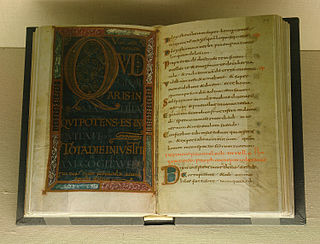
A psalter is a volume containing the Book of Psalms, often with other devotional material bound in as well, such as a liturgical calendar and litany of the Saints. Until the emergence of the book of hours in the Late Middle Ages, psalters were the books most widely owned by wealthy lay persons. They were commonly used for learning to read. Many Psalters were richly illuminated, and they include some of the most spectacular surviving examples of medieval book art.

The Irish Gospels of St. Gall or Codex Sangallensis 51 is an 8th-century Insular Gospel Book, written either in Ireland or by Irish monks in the Abbey of St. Gall in Switzerland, where it is now in the Abbey library of St. Gallen as MS 51. It has 134 folios. Amongst its eleven illustrated pages are a Crucifixion, a Last Judgement, a Chi Rho monogram page, a carpet page, and Evangelist portraits.

Carolingian art comes from the Frankish Empire in the period of roughly 120 years from about 780 to 900—during the reign of Charlemagne and his immediate heirs—popularly known as the Carolingian Renaissance. The art was produced by and for the court circle and a group of important monasteries under Imperial patronage; survivals from outside this charmed circle show a considerable drop in quality of workmanship and sophistication of design. The art was produced in several centres in what are now France, Germany, Austria, northern Italy and the Low Countries, and received considerable influence, via continental mission centres, from the Insular art of the British Isles, as well as a number of Byzantine artists who appear to have been resident in Carolingian centres.

The Folchart Psalter, or Folchard Psalter, is a Carolingian illuminated manuscript. It was produced about 872–883 in the scriptorium of the Abbey of St. Gall, Switzerland, under the direction of the scribe Folchardus, usually modernized as Folchard or Folchart.
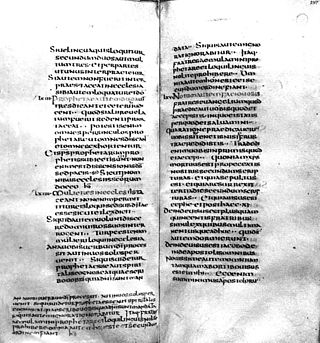
The Codex Fuldensis, also known as the Victor Codex, designated by F, is a New Testament manuscript based on the Latin Vulgate made between 541 and 546. The codex is considered the second most important witness to the Vulgate text; and is also the oldest complete manuscript witness to the order of the Diatessaron. It is an important witness in any discussion about the authenticity of 1 Corinthians 14:34-35 and the Comma Johanneum. It is one of the earliest dated manuscripts of the New Testament. It was corrected until 2 May, 546 AD.
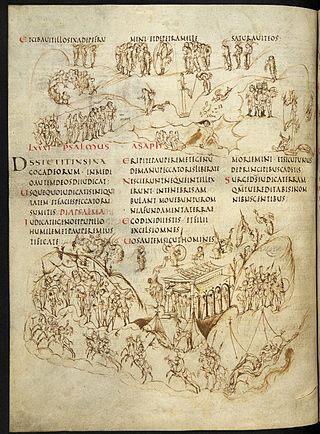
The Utrecht Psalter is a ninth-century illuminated psalter which is a key masterpiece of Carolingian art; it is probably the most valuable manuscript in the Netherlands. It is famous for its 166 lively pen illustrations, with one accompanying each psalm and the other texts in the manuscript. The precise purpose of these illustrations, and the extent of their dependence on earlier models, have been matters of art-historical controversy. The psalter spent the period between about 1000 to 1640 in England, where it had a profound influence on Anglo-Saxon art, giving rise to what is known as the "Utrecht style". It was copied at least three times in the Middle Ages. A complete facsimile edition of the psalter was made in 1875, and another in 1984 (Graz).

The Latin Psalters are the translations of the Book of Psalms into the Latin language. They are a resource used in the Liturgy of the Hours and other forms of the canonical hours in the Latin liturgical rites of the Catholic Church.

Tuotilo was a Frankish monk at the Abbey of Saint Gall. He was a composer, and according to Ekkehard IV a century later, also a poet, musician, painter and sculptor. Various trope melodies can be assigned to Tuotilo, but works of other mediums are attributed with less certainty. He was a student of Iso of St. Gallen and friends with the fellow monk Notker the Stammerer.

The Ebbo Gospels is an early Carolingian illuminated Gospel book known for its illustrations that appear agitated. The book was produced in the ninth century at the Benedictine Abbaye Saint-Pierre d’Hautvillers. Its style influenced Carolingian art and the course of medieval art.

The Abbey Library of Saint Gall is a significant medieval monastic library located in St. Gallen, Switzerland. In 1983, the library, as well as the Abbey of St. Gall, were designated a World Heritage Site, as “an outstanding example of a large Carolingian monastery and was, since the 8th century until its secularisation in 1805, one of the most important cultural centres in Europe”.

Codex Sangallensis, designated by Δ or 037, ε76, is a Greek-Latin diglot uncial manuscript of the four Gospels. Using the study of comparative writing styles (palaeography), it is usually dated to the 9th century CE, though a few palaeographers would place it in the 10th century CE. It was given its current name by biblical scholar Johann Martin Augustin Scholz in 1830.
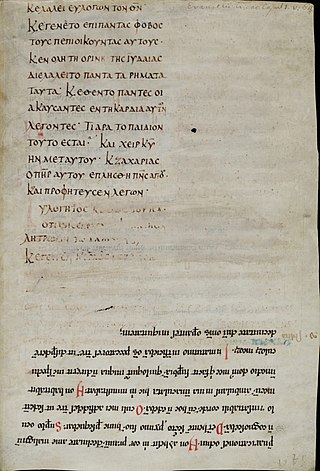
Uncial 0130, ε 80 (Soden), is a Greek uncial manuscript of the New Testament, dated palaeographically to the 9th-century. Formerly it was labelled by Wc.
Codex Sangallensis is the designation of codices housed at the Abbey library of Saint Gall in St. Gallen. The codices are index with a continuous arabic number, many of the codices have been digitized through the e-codices project in Switzerland with over 2000 of them freely available online.

Codex Sangallensis 1395 is a nineteenth-century compilation of fragments, and includes a 5th-century Latin manuscript of the New Testament, designated by Σ. The text, written on vellum, is a version of the Latin Vulgate.

The Codex Sangallensis 63, designated by S in some critical editions of the Bible, is a 9th-century Latin manuscript of the New Testament. The text, written on vellum, is a version of the Vulgate and contains the text of the Acts of the Apostles, Epistles, Book of Revelation, and non-biblical material. The manuscript has not survived in a complete condition, some parts of it have been lost. The original manuscript did not contain the Comma Johanneum, but it was added by a later hand on the margin.

The Dagulf Psalter is a late 8th-century Carolingian manuscript, and is one of the earliest examples of a codex emanating from the Court School of Charlemagne. The 161 page codex is written entirely in golden Carolingian minuscule script, and contains the Old Testament Psalms as well as a selection of Frankish Canticles. The Psalter is believed to have been created by the scribe Dagulf in 793-795 CE as a gift from Charlemagne to Pope Adrian I.
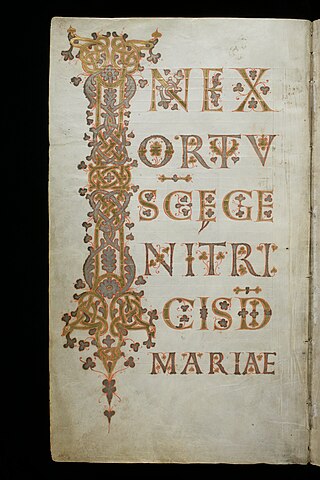
The Evangelium longum is an illuminated manuscript Latin evangeliary that was made around 894 at the Abbey of Saint Gall in Switzerland. It consists of texts drawn from the Gospels for the use of the preacher during Mass.

The Codex Sangallensis 484 is an early medieval music manuscript, produced in the abbey of St. Gallen and stored in the Abbey Library in St. Gallen. The manuscript is known for its exhaustive collection of so-called tropes, meaning melodic or textual extensions to previously existing liturgic chants. As this particular manuscript is among the most extensive collections of such tropes from the eastern Frankish kingdom, it plays an important role in the history of music.

The Codex Sangallensis 381 is an early medieval music manuscript, produced in the abbey of St. Gallen and stored in the Abbey Library in St. Gallen. The manuscript is known for its exhaustive collection of so-called tropes, verses, and sequences. Together with the Cod. Sang. 484, this manuscript makes an important contribution to one of the most exhaustive collections of such compositions in the East Frankish kingdom and thus plays an important role in the history of music.

















